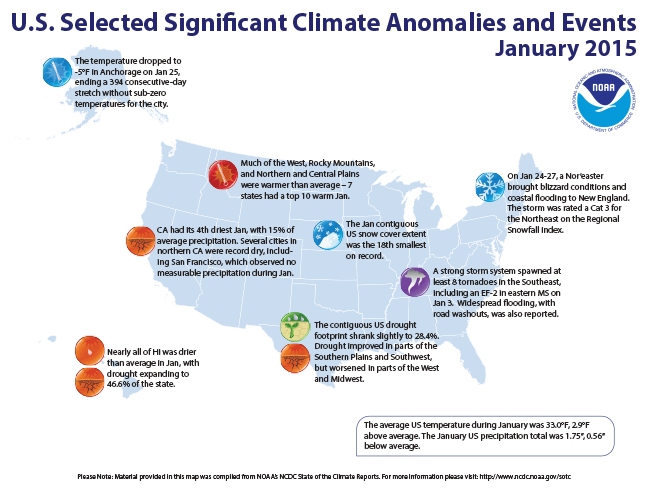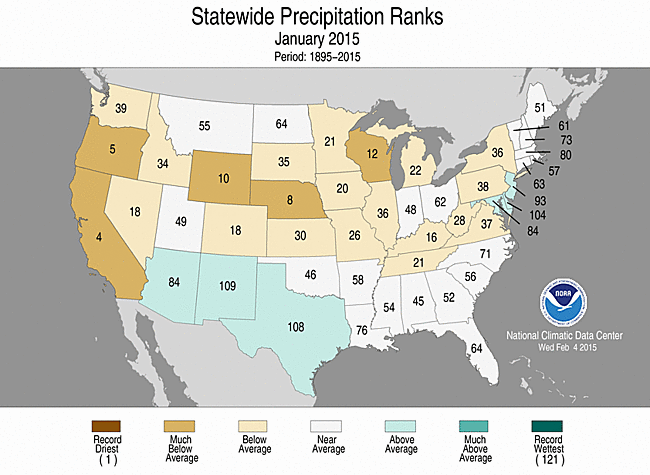Monthly Report Summary Information
The Monthly Report Summary Information is a synopsis of the collection of national and global summaries released each month.
National Summary Information - January 2015
See Full Report
For extended analysis of regional temperature and precipitation patterns,as well as extreme events, please see our full report that will be released on February 11th.
January was warm and dry overall for the contiguous U.S. despite coolness across parts of the South and Northeast
During January, the average contiguous U.S. temperature was 33.0°F, 2.9°F above the 20th century average. This ranked as the 24th warmest January in the 1895-2015 record and marked the warmest January since 2012. The average contiguous U.S. precipitation was 1.75 inches, 0.56 inch below average, and ranked as the 18th driest January in the 121-year record. Most of the Lower 48 was drier than average, with drought worsening in parts of the West and Midwest.
U.S. climate highlights: January 2015
- Locations from the West Coast, through the Intermountain West, and into the Northern Plains were warmer than average, where seven states — California, Idaho, Nevada, Oregon, Utah, Washington, and Wyoming — had a top 10 warm January. No state was record warm for the month. Parts of the Southern Plains and Northeast were cooler than average while no state had a top 10 cool January.
- According to preliminary data, during January, there were 3,499 warm daily temperature records broken or tied (1,906 warm maximum and 1,593 warm minimum), compared to 775 cool daily temperature records broken or tied (441 cool maximum and 334 cool minimum).
- Most areas of the U.S. were drier than average, especially the West, Central Plains, and Midwest, where four states — California, Nebraska, Oregon, and Wyoming — had a top 10 dry January. The Southern Rockies and Plains and the coastal Mid-Atlantic were wetter than average, but no state had a monthly precipitation value ranking among their 10 wettest.
- California had its fourth driest January, with 15 percent of average monthly precipitation. This was the third consecutive January with much-below-average precipitation for the state, which is typically the wettest month of the year. Several cities in northern California were record dry, including San Francisco, which received no measureable precipitation in January for the first time on record. January is also climatologically the wettest month of the year for San Francisco, according to the 1981-2010 normals.
- According to analysis of NOAA data by the Rutgers Global Snow Lab, the January contiguous U.S. snow cover extent was 1.3 million square miles, 75,000 square miles below the 1981-2010 average. This marked the 18th smallest January snow cover extent in the 49-year period of record. Despite the below-average monthly snow cover extent, a powerful Nor'easter impacted the East Coast in late January, bringing blizzard conditions and coastal flooding to New England. Boston, Massachusetts, received 24.4 inches of snow, the sixth highest single-storm snowfall total for the city. The storm was rated a Category 3 ("Major") for the Northeast, based on the Regional Snowfall Index that considers both the snow amount and population affected across the region.
- According to the February 3rd U.S. Drought Monitor report, 28.4 percent of the contiguous U.S. was in drought, down slightly from 28.7 percent at the end of December. Drought conditions worsened across parts of the West, Central Rockies, Midwest, and Ohio River Valley. Drought conditions improved in parts of the interior Northwest, Southern Plains, Southwest, and the Lower Mississippi River Valley. Drought conditions also worsened for much of the Hawaiian Islands.
For extended analysis of regional temperature and precipitation patterns, as well as extreme events, please see our full report that will be released on February 11th.
 NOAA's National Centers for Environmental Information
NOAA's National Centers for Environmental Information


